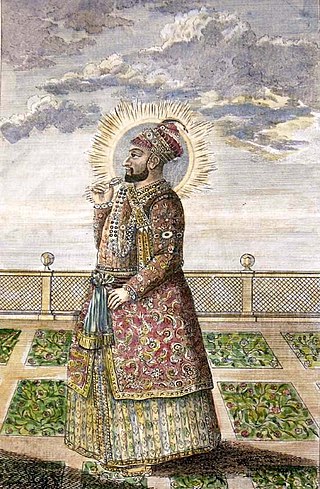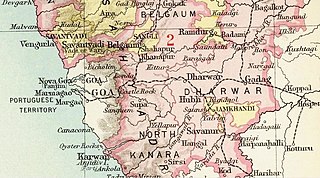
Tipu Sultan, commonly referred to as Sher-e-Mysore or "Tiger of Mysore", was an Indian ruler of the Kingdom of Mysore based in South India. He was a pioneer of rocket artillery. He expanded the iron-cased Mysorean rockets and commissioned the military manual Fathul Mujahidin. He deployed the rockets against advances of British forces and their allies during the Anglo-Mysore Wars, including the Battle of Pollilur and Siege of Srirangapatna.

Hyder Ali was the Sultan and de facto ruler of the Kingdom of Mysore in southern India. Born as Hyder Ali, he distinguished himself as a soldier, eventually drawing the attention of Mysore's rulers. Rising to the post of Dalavayi (commander-in-chief) to Krishnaraja Wodeyar II, he came to dominate the titular monarch and the Mysore government. He became the de facto ruler, King of Mysore as Sarvadhikari by 1761. During intermittent conflicts against the East India Company during the First and Second Anglo–Mysore Wars, King Hyder Ali was the military leader.

The Maratha Confederacy, also referred to as the Maratha Empire, was an early modern polity in the Indian subcontinent. It comprised the realms of the Peshwa and four major independent Maratha states often subordinate to the former. It was established in 1674 with the coronation of Shivaji as the Maratha Chhatrapati and recognised by Emperor Bahadur Shah I as a tributary state in 1707 following a prolonged rebellion. Following this, the Marathas continued to recognise the Mughal emperor as their nominal suzerain, similar to other contemporary Indian entities, though in practice, imperial politics at Delhi were largely influenced by the Marathas between 1737 and 1803.

Madhavrao I was the son of Peshwa Balaji Bajirao and grandson of Peshwa Bajirao I who served as 9th Peshwa of the Maratha Confederacy. During his tenure, the Maratha Confederacy recovered from the losses they suffered during the Third Battle of Panipat, an event known as Maratha Resurrection.

The First Anglo-Mysore War (1767–1769) was a conflict in India between the Sultanate of Mysore and the East India Company. The war was instigated in part by the machinations of Asaf Jah II, the Nizam of Hyderabad, who sought to divert the company's resources from attempts to gain control over the Northern Circars.

Narayanrao was the 10th Peshwa of the Maratha Confederacy from November 1772 until his assassination in August 1773. He married Gangabai Sathe who later gave birth to Sawai Madhavrao.

Ahmad Shah Bahadur, also known as Mirza Ahmad Shah or Mujahid-ud-Din Ahmad Shah Ghazi, was the fourteenth Mughal emperor, born to Emperor Muhammad Shah. He succeeded his father to the throne in 1748, at the age of 22. When Ahmed Shah Bahadur came to power, the Mughal Empire started to decline. Furthermore, his administrative weakness eventually led to the rise of the usurping Imad-ul-Mulk.

Raghunathrao Bhat, also known as Ragho Ballal or Raghoba Dada, was the younger son of Peshwa Bajirao I who served as the 11th Peshwa of the Maratha Confederacy for a brief period from 1773 to 1774.
Sira is a taluk of Tumkur district in the state of Karnataka, India. Its headquarters, Sira city lies on the NH 48 .It is the largest taluk in district by area.Second largest in population and economy.It is most developed regions in district after headquarters.

Dhondia Wagh was a military soldier and adventurer in 18th century India. He started his career in the service of Hyder Ali, the ruler of Mysore. During the Third Anglo-Mysore War, he deserted Ali's successor Tipu Sultan, and subsequently raided territories on the Maratha-Mysore border. After the Marathas forced him to retreat, he sought refuge from Tipu and converted to Islam, changing his name to Malik Jahan Khan. After Tipu's death in the Fourth Anglo-Mysore War, he raised a force comprising soldiers from the former Mysore Army, and took control of northern part of the Mysore Kingdom. He styled himself as Ubhaya-Lokadheeshwara. The British East India Company as well as the Maratha Peshwa sent armies to check his rising power. He was ultimately defeated and killed by a British force led by Arthur Wellesley.

The Siege of Trichinopoly was part of an extended series of conflicts between the Nizam of Hyderabad and the Maratha Empire for control of the Carnatic region. On 29 August 1743, after a six-month siege, Murari Rao surrendered, giving Nizam ul Mulk (Nizam) the suzerainty of Trichinopoly. By the end of 1743, the Nizam had regained full control of Deccan. This stopped the Maratha interference in the region and ended their hegemony over the Carnatic. The Nizam resolved the internal conflicts among the regional hereditary nobles (Nawabs) for the seat of governor (Subedar) of Arcot State, and monitored the activities of the British East India company and French East India Company by limiting their access to ports and trading.

Jamkhandi State was one of the Maratha princely states of British India. It was founded in 1811 and its capital was at Jamakhandi. It was administered as part of the Deccan States Agency of the Bombay Presidency and was one of the former states of the Southern Maratha Country. The area that was under this princely state is part of present day Karnataka.

Savanur State, Nawab of Savanur was one of the princely states in British India. The last ruler of the state acceded to the Dominion of India on 8 March 1948, becoming part of the Bombay State. Later in 1956, it transferred to Mysore State in what is now Karnataka.
The Battle of Saunshi was fought between the Kingdom of Mysore and the Maratha Confederacy in 1777. Hyder Ali attempted to try to regain his lost territories of Malabar and Coorg from the Marathas and was successful in doing so. Hyder Ali decided to attack the Marathas at Saunshi. Hyder Ali sent his trusted general Muhammad Ali to attack the Maratha garrison stationed at Saunshi. The result of the battle was a decisive victory for Mysore and Hyder Ali against the Maratha forces. Maratha Chief Konher Rao was killed in the battle and Pandurang Rao was captured and taken as a prisoner by the Mysore forces.

Haripant Phadke, known as Hari Pant was a general of the Maratha Confederacy. Hari Pant became a general during the siege of Badami on 20 May 1786 against the Kingdom of Mysore. He became general of 50,000 and won the war in Maratha-Mysore War.

The Battle of Rattihalli, fought in 1764, pitted the forces of the Maratha Confederacy against those of the Mysore forces led by Hyder Ali. The Maratha army was commanded by Peshwa Madhavrao.

The siege of Sira was an offensive conducted by Hyder Ali.
Nizam-ul-Mulk established his authority in Karnataka, while Chanda Saheb rose to prominence. Shahu appointed Raghuji Bhonsle and Fateh Singh to collect tribute from Karnataka and protect the Tanjore region against Chanda Saheb. Raghuji and Fateh Singh advanced on Arcot, where Dost Ali Khan fell fighting the Marathas. His son, Safdar Ali, sought refuge in Vellore, and the valuables of the Nawab were sent to Pondicherry.
In 1753, Damaji Rao Gaekwad returned with reinforcements and advanced on Ahmedabad, which was soon invested. Jawanmard Khan of the Gaikwar managed to enter but ultimately had to surrender with honors. The Marathas granted him an estate in north-west Gujarat, but it was later reclaimed. Raghunath Rao captured Ahmedabad in April 1753, then went to Sorath and extracted tribute from the Mughals. The Mughals surrendered after the Marathas confirmed the conditions he proposed.
In September 1764, the Marathas under Madhavrao I began a siege of the Dharwar fort, held by Mir Faizulla’s brother. Despite a two-month resistance, the situation for the defenders grew dire. Haidar sent Mir Faizulla to relieve the fort, but Gopal Rao Patwardhan and Anand Rao Raste prevented his intervention. The fort was surrendered on 6 November 1764. The Marathas then fortified Dharwar, leaving Haidar with only Bankapur. Efforts to negotiate peace were unsuccessful.













